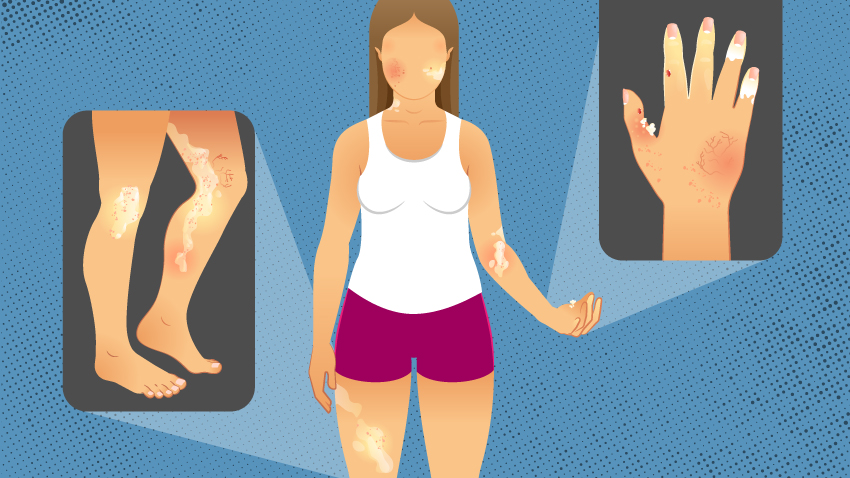Scleroderma
Scleroderma is an autoimmune connective tissue and rheumatic disease that causes inflammation in the skin and other areas of the body. The word “scleroderma” comes from two Greek words: “sclero” meaning hard, and “derma” meaning skin. Hardening of the skin is one of the most visible manifestations of the disease. Scleroderma is a group of rare diseases that more often affects women. It commonly occurs between the ages of 30 and 50.
People with limited scleroderma usually have Raynaud’s symptoms for years (often 5 to 10 years) before other signs of scleroderma are noted. However, even the limited form can, in rare cases, present with internal organ involvement without being preceded by Raynaud’s symptoms. Patients with limited scleroderma are less likely to develop severe lung, heart, or kidney involvement than patients with diffuse disease, although these complications can occur late in the disease process.
Many patients with limited scleroderma eventually develop a cluster of symptoms that are listed using the acronym CREST. CREST is an acronym for calcinosis, Raynaud’s phenomenon, esophageal dysfunction, sclerodactyly and telangiectasia. Calcinosis is the abnormal accumulation of calcium salts under the skin and in many other organs. It presents as small, localized, hard masses on fingers, forearms, or other pressure points. Raynaud’s phenomenon is characterized by the intermittent loss of blood to various parts of the body – particularly the fingers, toes, nose, and/or ears after exposure to cold and causes tingling sensations, numbness, and/or pain. This can result in ulceration and necrosis of the fingertips and in some severe cases, lead to amputation of the affected digits. Dysfunction of the lower esophagus results in chronic heartburn and possible esophageal scarring. If the heartburn symptoms are not well controlled, the repeated acid exposure can eventually lead to a condition known as Barrett’s esophagus, a pre-cancerous condition. The esophagus may eventually have areas that are narrowed and swallowing may become difficult.
The small intestine may also lose the ability to push food through to the large intestine leading to malabsorption and increased bacterial growth in the small intestine. Sclerodactyly, a condition in which the skin becomes thin, shiny, and bright, results in decreased function of the fingers and toes. Telangiectasia, the appearance of small blood vessels near the surface of the skin, usually on the face, hands, and in the mouth, is unsightly but not debilitating. Depending on the antibody profile for patients diagnosed with limited scleroderma, they can be at increased risk of developing kidney failure, lung fibrosis, and pulmonary artery hypertension, but these complications usually occur at a much later date than with diffuse scleroderma.
With diffuse scleroderma, there is usually a short interval (weeks or months) between the development of Raynaud’s and significant additional symptoms, and, in some cases, Raynaud’s will not be the first symptom. Relatively rapid skin changes often occur in the first few months of the disease and continue to progress over the next 2 to 3 years. This is often followed by a remission of the skin changes, and the skin either thins or sometimes returns toward normal thickness. The severe fibrosis of the skin, especially in the fingers and hands, can cause significant disability. Diffuse scleroderma can also include a wide range of potential complications, including inflammation of the muscles, swelling of the fingers and/or hands, microvascular abnormalities, gastrointestinal malfunction, lung fibrosis, pulmonary artery hypertension, progressive kidney failure, and cardiovascular problems. Internal organ involvement often occurs early in diffuse scleroderma and can be the initial presenting symptom.
Disclaimer: Health experts suggest that you talk to your doctor before you start, change or modify your medications, lifestyle or current treatment regimen.
Reference:
Read more about Scleroderma here:
https://www.scleroderma.org/site/SPageNavigator/patients_whatis.html#.Xuocp6ZYaUk

